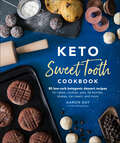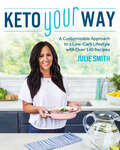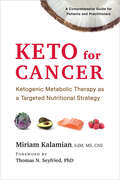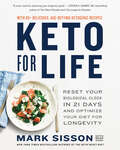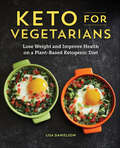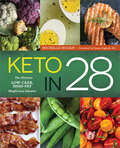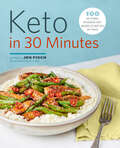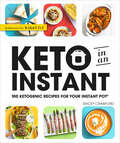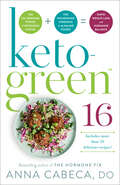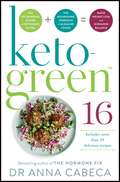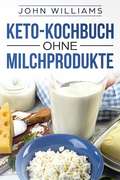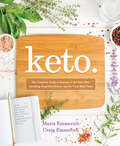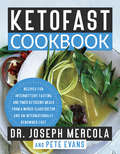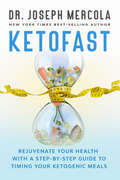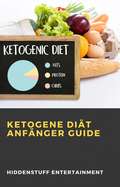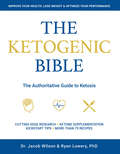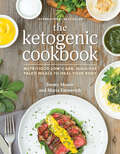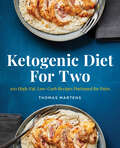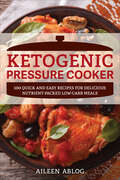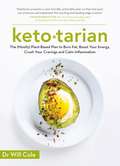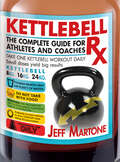- Table View
- List View
Keto Sweet Tooth Cookbook: 80 Low-carb Ketogenic Dessert Recipes for Cakes, Cookies, Pies, Fat Bombs, Shake
by Aaron DayYou can enjoy delicious desserts and sweet treats with this cookbook, and you can make them all low-carb and sugar-free!With 80 easy recipes and beautiful photography throughout, Keto Sweet Tooth Cookbook is the only keto desserts book you'll ever need. Burn fat, boost your energy, and enjoy the desserts you love. In no time, you'll be making everything from low-carb cakes and cookies to pies, fat bombs, shakes, ice creams, candies, and smoothies. Every low-carb recipe is sugar-free and includes essential macros along with clear, easy-to-follow instructions for making virtually any sweet treat you'd ever want. Keto Sweet Tooth Cookbook will satisfy even the most persistent sweet tooth, but without all the sugar and excess carbs!Here's what you'll find in Keto Sweet Tooth Cookbook: • 80 dessert and sweet treat recipes for cakes, cupcakes, muffins, custards, pies, confections, fat bombs, frozen treats, and more, and all with essential keto macros • Helpful tips for using sweeteners, including which sweeteners to buy and which to avoid, to ensure your keto desserts are both delicious and keto-friendly • Guidance on using nut flours and binding agents to achieve perfect results that are just as good or better than traditional desserts and treats • Tips for adjusting cooking techniques to achieve perfect results every time, including advice on stocking your kitchen with essential keto ingredients
Keto Your Way
by Julie SmithIn her new book, Keto Your Way, Julie Smith shows you how to create a customized plan for adopting a ketogenic lifestyle tailored to your specific needs, taste buds, and budget. With so many ways to approach keto, this book provides you with the information and tools you need to find the approach that matches your lifestyle and to make informed food choices that satisfy your unique nutritional needs. Julie also teaches you how to eat intuitively and to listen to your body in a way that takes the “diet” out of keto and makes it about living a life that is sustainable for you. With a keto template and Julie’s guidance, you can lose weight and become your healthiest you! As a busy mother of four, Julie knows the value of time and the realities of needing to stick to a budget. In Keto Your Way, she presents more than 140 simple and easy family-friendly recipes made with budget-friendly ingredients that can be found in just about any grocery store. She also offers tips and tricks for overcoming hurdles to achieve lasting success. Leave behind the one-size-fits-all approach and embrace keto—your way.
Keto for Cancer: Ketogenic Metabolic Therapy as a Targeted Nutritional Strategy
by Miriam Kalamian&“Keto for Cancer brings clarity to this emerging science and makes implementation of this information straightforward and uncomplicated.&”—David Perlmutter, New York Times bestselling author&“This book addresses every question or concern that cancer patients might have in using a ketogenic metabolic strategy for managing their cancer.&”—Thomas Seyfried ,PhDTHE comprehensive guide for patients and practitioners from a foremost authority in the emerging field of metabolic therapies for cancer.Although evidence supporting the benefits of ketogenic diet therapies continues to mount, there is little to guide those who wish to adopt this diet as a metabolic therapy for cancer. Keto for Cancer fills this need. Nutritionist Miriam Kalamian has written the book to lay out comprehensive guidelines that specifically address the many challenges associated with cancer, and particularly the deep nutritional overhaul involved with the ketogenic diet.Kalamian, a leading voice in the keto movement, is driven by passion from her own experience in using the ketogenic diet for her young son. Her book addresses the nuts and bolts of adopting the diet, from deciding whether keto is the right choice to developing a personal plan for smoothly navigating the keto lifestyle. It is invaluable for both beginners and seasoned users of the ketogenic diet, as well as for health-care professionals who need a toolkit to implement this targeted metabolic therapy.The book guides readers to a deeper understanding of the therapeutic potential of the ketogenic diet—which extends well beyond simply starving cancer—emphasizing the powerful impact the diet has on the metabolism of cancer cells.Nutritional nuances and meal templates and tracking tools are explored in sections such as:Fasting ProtocolsKnow What&’s in the Foods You EatPreparing Keto MealsPut Your Plan Into ActionKalamian also discusses important issues such as self-advocacy empowering readers by offering tips on how to critically examine cancer-care options and then incorporate what resonates into a truly personalized treatment plan.
Keto for Life: Reset Your Biological Clock in 21 Days and Optimize Your Diet for Longevity
by Mark Sisson Brad KearnsFrom the health expert and New York Times bestselling author of The Keto Reset Diet comes a groundbreaking ketogenic eating and lifestyle plan tailored for longevity, health, and happiness. At age sixty-six, ancestral health movement leader Mark Sisson is still in peak athletic condition and exceptional health. He credits his ketogenic diet and complementary lifestyle practices as the reason, and rightly so—research has confirmed the anti-aging benefits of following a high-fat, moderate-protein, low-carb eating pattern.In Keto for Life, you&’ll implement a holistic plan of action to live a long, healthy, and happy life with Sisson&’s Four Pillars of Longevity: Metabolic Flexibility, Movement and Physical Fitness, Mental Flexibility, and Rest and Recovery. Through mindful eating, moving, thinking, and resting, you can initiate DNA repair and cellular rejuvenation to actually reverse the aging process and halt cognitive or physical decline.You&’ll discover how to escape carbohydrate dependency once and for all, incorporate the most potent ketogenic superfoods and supplements available to boost brain function and protect against heart disease, dial in your sleep habits and recovery patterns for an immediate energy boost, and successfully manage modern life stressors like hyperconnectivity. And with the game-changing 21-Day Biological Clock Reset, you&’ll create a daily longevity routine that feels natural and easy to permanently maintain.Featuring more than eighty delicious, nutrient-dense ketogenic recipes from leading health and gourmet experts, Keto for Life will unlock your full longevity potential and keep you living well.
Keto for Vegetarians: Lose Weight and Improve Health on a Plant-Based Ketogenic Diet
by Lisa DanielsonYes, you can eat keto as a vegetarian. Here's how.Although you may think the ketogenic diet is designed for meat eaters, vegetarians can enjoy its many benefits, too. Following the delicious plant-based recipes in Keto for Vegetarians can help with things like weight management, inflammation, and even mental clarity.Learn exactly how the ketogenic diet works in your body, then use the shopping lists and 14-day meal plan to get started right away. Tips for success make it easy to shop for groceries, set up your kitchen for ketogenic diet cooking, and even figure out how to stay on track when eating out. The 100 tasty, easy-to-make recipes like Portobello Mushroom Burger with Avocado, Cheesy Dill Fat Bombs, and Parmesan Zucchini Chips will help provide the ketones you need to keep going.Inside Keto for Vegetarians you'll find:In to win—Tricks and hints to help you get keto-adapted and power through carb cravings.Keto veto—Learn tasty alternatives to foods that aren't keto friendly, so that you can stay on track without sacrificing flavor.Love your leftovers—Get the most from your meals with tips on how to best save your leftovers for future keto-friendly snacks.Enjoy the benefits of the ketogenic diet and vegetarian lifestyle all on one plate.
Keto in 28: The Ultimate Low-Carb, High-Fat Weight-Loss Solution
by Michelle HoganGo keto in 28 days with the ultimate cookbook and meal planResearch shows that a ketogenic diet can help you lose weight, boost your energy levels, and feel healthier. Keto in 28 is a complete plan that shows you how to succeed on the ketogenic diet, with weekly menus, delicious recipes, and complete diet guidance. It's your key to achieving ketosis and transforming how you eat.Go beyond other keto books with:28 days of planned meals—Cut carbs and curb sugar cravings with four weeks of detailed keto recipes for every meal, complete with nutrition information.A quick keto primer—Learn what to expect with an overview of the keto diet, the science behind it, and the foods to embrace and avoid.Keto kitchen advice—Find suggestions on altering the menus to your taste and stocking your kitchen with ketogenic diet staples.Discover the keto 28 day meal plan cookbook that helps you jump into a healthier diet and lifestyle.
Keto in 30 Minutes: 100 No-Stress Ketogenic Diet Recipes to Keep You On Track
by Jen FischKeep up with keto even on your busiest days with fast, no-stress recipes from Keto in 30 Minutes. Eating keto doesn't need to complicate your schedule. Keto in 30 Minutes offers the fastest recipes to stay on track with the ketogenic diet no matter how busy life gets. From prepping ingredients to taking your first bite, all of the recipes in this ketogenic diet cookbook take 30 minutes or less to whip up from start to finish. With 5-ingredient and one-pot or pan recipes, Keto in 30 Minutes makes flavorful, low-carb and high-fat meals an everyday staple at your table. Whether you're new to the ketogenic diet or have been following the lifestyle for years, these recipes make cooking keto every day easy with: Keto 101 that provides everything you need to know to make the ketogenic diet a part of your day-to-day life, including a basic overview of the diet along with lists of foods to enjoy and avoid. 100 recipes for breakfast, lunch, dinner, and dessert, that are table-ready in 30-minutes or less. Handy tips to prep you for a lifetime of success on the ketogenic diet, and make eating keto faster and easier than ever. Start your day with Baked Eggs in Avocado, or wind it down with a Keto Chicken-Fried Steak for dinner—no matter what you're in the mood to eat, Keto in 30 Minutes makes it easy to stay in ketosis all day, every day.
Keto in an Instant: 100 Ketogenic Recipes for Your Instant Pot
by Stacey CrawfordEnjoy 100 simple and delicious keto-friendly recipes with this officially authorized Instant Pot cookbook! The ketogenic diet, with its emphasis on high-fat and low-carb recipes, has been embraced as a radical new way to eat to lose weight and get healthy, but cooking keto can be challenging and time consuming. The Instant Pot's versatility as a multi-cooker has changed all of that and made cooking keto easier and more convenient. Keto in an Instant features 100 simple, low-carb ketogenic recipes each designed to be made in the Instant Pot. Every recipe includes clear, detailed instructions and essential nutrition information. Readers will gain insight on how the ketogenic diet works and how to benefit from a ketogenic eating plan, as well as tips and tricks for using and maintaining an Instant Pot.Included in Keto in an Instant: • 100 easy-to-make recipes for breakfasts, mains, soups and stews, sides, desserts, and more, each with clear, detailed instructions • Essential nutrition information and macros for every recipe, with tips for simple substitutions and for making many recipes dairy-free • Helpful insight for understanding how the keto diet works and how it benefits your body • Simple tips and tricks for getting the most out of your Instant Pot and guidance on stocking your kitchen for cooking keto
Keto in an Instant: More Than 80 Recipes for Quick and Delicious Keto Meals Using Your Pressure Cooker
by Jen FischFrom the bestselling author of The Easy 5-Ingredient Ketogenic Diet Cookbook comes an essential guide to making keto meals in the Instant Pot.Bestselling author Jen Fisch knows that making lifestyle changes is challenging. Several years ago, she was suffering from multiple autoimmune diseases when her doctor suggested she try the keto diet. Her first thought was, That seems too hard, and I don’t want to give up my favorite foods. But soon, after a lot of trial and error and recipe testing and developing, the single working mom figured out how to make a keto eating plan work for her and her daughter. She turned her tips and recipes into a hugely successful blog, Keto in the City—and later included them in her cookbooks. Today, Jen is an established authority in the keto community and regarded as a trusted expert. In her new cookbook, Keto in an Instant, Jen explores one of the time-saving cooking tools her audience loves most: The Instant Pot. Keto in an Instant features more than 80 recipes that make use of the pressure cooker, spanning every meal of the day. From hearty dishes like Short Rib Ragu, Shredded Brisket Bowls, and Chicken Parm Meatballs; to soups and stews like Buffalo Chicken Chowder, Lasagna Soup, and Coconut Shrimp Soup; to treats like Blackberry Pudding Cupcakes, Maple Bacon Pancake Bites, and Strawberry Cinnamon Rolls, Jen offers healthy and delicious dishes that every member of the family can enjoy without feeling deprived.In addition to healthy, mouthwatering recipes, Jen shares her personal success story, the key principles of keto, and a comprehensive guide to foolproof cooking with the Instant Pot. She makes the keto lifestyle simple, delicious, and budget-friendly—for everyone.
Keto-Green 16: The Fat-Burning Power of Ketogenic Eating + The Nourishing Strength of Alkaline Foods = Rapid Weight Loss and Hormone Balance
by Anna CabecaAn innovative 16-day plan that combines the fat-burning benefits of a ketogenic diet with the brain-clearing and keto-flu protection of alkaline food, by the USA Today bestselling author of The Hormone Fix.&“A powerful program that paves the way for lasting health, longevity, and disease resistance.&”—David Perlmutter, MD, New York Times bestselling author of Grain BrainAre you having a hard time losing weight? Do you suffer from brain fog, lack of focus, or poor memory? Do you run out of energy halfway through the day? Do you have unwanted cravings? If you answered &“yes&” to any of these questions, join the club! In this revolutionary book, Dr. Anna Cabeca shares a proven way to finally give you the results you want, need, and deserve. There is no question that going keto works. This strict high-fat/low-carb diet denies the body glucose as a main source of energy and instead promotes the production and use of ketone bodies as fuel. It&’s a great way to move you off a weight plateau, gain willpower, and get results fast. But going keto also often results in gastrointestinal discomfort, low energy, and moodiness—known as the &“keto flu&”—which makes the diet hard to sustain. The solution? Add alkaline foods—leafy greens, other vegetables, broths, healthy oils, nuts, and seeds—for a lifestyle that&’s more sustainable and easier on your body. In other words: Go Keto-Green and thrive!A triple-board-certified physician, Dr. Anna Cabeca developed her method through years of careful patient and test-panel research. In Keto-Green 16, she explains the science behind her innovation: Hormone production dips as a woman ages, leading to increased visceral fat. By pairing keto-diet staples with foods that bring the body&’s pH to a more alkaline level, you&’ll shed belly fat while balancing the hormones responsible for that bulkier midsection. And by fueling your brain with ketones—like rocket fuel instead of gasoline—you&’ll make better decisions, including healthier choices for what to eat. The unique nutritional balance of the Keto-Green 16 diet also boosts mood.With 16 days of what-to-eat instructions (including a version for vegetarians and vegans); more than 50 delicious breakfast, lunch, dinner, and snack recipes; information about the 16 best alkaline foods; a 16-hour intermittent-fasting strategy; 16-minute HIIT exercise routines; and a chapter outlining the specifics of the nutritional plan just for men; Keto-Green 16 will ensure that you skip the flu and get on with rapid and amazing weight loss.
Keto-Green 16: The Fat-Burning Power of Ketogenic Eating + The Nourishing Strength of Alkaline Foods = Rapid Weight Loss and Hormone Balance
by Anna CabecaIn 2019 hormone and female health specialist Dr Anna Cabeca brought you The Hormone Fix, a comprehensive and practical guide to getting through the menopause without all the health problems associated with what can be a difficult if not devastating time in a woman's life.The natural follow-up to this is the definitive diet book, based on the scientifically tried and tested developed by Dr Cabeca over her years working with patients. On Keto-Green 16 you will expect to:Lose weight rapidlyTrim your waist and stomachFlush out toxinsExercise less but get better resultsEnjoy greater physical energyDevelop sharper thinkingOn the Keto-Green 16 diet you can expect to feel energetic and motivated because the weight loss is rapid but you will not feel hungry, due to a shift from glucose to ketones. This is a 'grab-the-bull-by-the-horns' approach that you will want to embrace as a way of life.
Keto-Kochbuch ohne Milchprodukte
by Katrin KorkowskiDieses Buch ist ein guter Wegweiser zu einer milchfreie Keto Diät. Hier wird beschrieben was ist Keto und wie lebe ich danach. Hinzukommen eine Fülle von leckeren Rezepten.
Keto: The Complete Guide To Success On The Ketogenic Diet, Including Simplified Science And No-cook Meal Plans
by Maria EmmerichThe ketogenic diet has gained in popularity, but that has led to some bad information being shared. You can do keto right, and you can do keto wrong. This book is all about how to do keto the right way! Despite what health science has beaten into us over the last fifty or so years, humans thrive on high-fat, low-carb diets. Millions of people around the world have discovered that a ketogenic lifestyle is the key to weight loss, disease prevention and intervention, and a more vibrant life. Gone are the days of constant hunger and low energy. This book leads you on a path to better health, a slimmer waistline, elimination of cravings, and endless energy. Craig and Maria Emmerich have partnered to write a book that digs deep into the science of ketogenic dieting, explaining how dozens of diseases can be cured or controlled through keto and how ketogenic diets are fueling a new breed of athlete—all in an easy-to-understand way that breaks down the complicated science for you. Keto is the definitive resource to the ketogenic lifestyle. Inside, you’ll learn How you can beat cancer, obesity, metabolic syndrome, coronary artery disease, high cholesterol, Alzheimer’s, dementia, ADHD, anxiety, and depression into submission by making some simple yet impactful changes to your diet. How cholesterol and diabetes medications could very well be making you sicker rather than better. How generations of bad advice—designed to sell sugar, not health—has killed millions who blindly trusted the medical community and, worse still, the government to tell them the truth. How overconsumption of carbohydrates is bad for your health and could be at the root of what ails you. How changing your inputs—the foods you eat—can change your outputs, meaning your quality of life. How our bodies work, including oxidative priority, fat flux, and lipolysis, explained in such a way that everyone can understand how our bodies really process what we put into them. How inflammation is at the root of many diseases and how modern diets that are rife with sugar, carbs, and omega-6 oils are sending us to early graves. How hormones control mood swings, sex drive, blood sugar levels, muscle tone, fat-burning ability, metabolism, the immune system, and much more—and how adopting a ketogenic lifestyle can change your waistline and your life! How to stock your pantry with the right foods and make meal plans that are delicious and easy to follow and, most importantly, are the pathway to a longer, healthier life. How you can build muscle and perform at your best on a low-carb, high-fat diet. No, we’re not making that up! Which foods are the most nutrient dense to feed our cells the vitamins and minerals they need. How to sort through the confusion and conflicting information about what a ketogenic diet is. This book clears it all up, dispelling the myths of ketogenic diets. So, enjoy those healthy animal proteins. Gnaw on that rib bone. And say no to that plate of “heart-healthy” pasta. New York Times bestselling author Maria Emmerich and her husband, Craig, are going to take you on a journey to a new life—one that helps you lose weight, build muscle, and live the life nature intended you to live!
KetoFast Cookbook: Recipes for Intermittent Fasting and Timed Ketogenic Meals from a World-Class Doctor and an Internationally Renowned Chef
by Pete Evans Dr. Joseph MercolaDr. Joseph Mercola, one of the world's foremost authorities on alternative health, joins with top chef Pete Evans for an illustrated guide to timing ketogenic meals for optimal health, weight loss, and more. Includes more than 100 delicious recipes to make ketogenic eating easy and enjoyable.You are what you eat--or is it more that you are when you eat?Natural-health expert Dr. Joseph Mercola and top Australian chef Pete Evans share a firm belief that food can be medicine--that what we eat offers us powerful tools to reshape our health. In their second co-authored cookbook, they explore the science behind intermittent fasting and the practice of timing ketogenic meals for maximum health benefits--a unique combination of principles they call KetoFasting.Drawing on Dr. Mercola's expertise and visionary work in natural medicine, and Pete Evans's experience as an award-winning restaurateur, cookbook author, and TV chef, this book offers: * Insight into the history and cultural relevance of fasting * Guidance for a healthy ketogenic lifestyle * Strategies to boost your body's detox processes--including a detailed guide to using sauna therapy for detoxing * Healthy supplements to support KetoFasting * Delicious recipes for soups, broths, snacks, and more --all illustrated with mouthwatering full-color photographs shot in Pete Evans's own studio * And much moreRead on to learn how KetoFasting can help you lose weight, treat disease, and feel better than ever before.
KetoFast: Rejuvenate Your Health with a Step-by-Step Guide to Timing Your Ketogenic Meals
by Dr. Joseph MercolaFrom Dr. Joseph Mercola, one of the world's foremost authorities on alternative health: a guide to using the principles of ketogenic eating, meal planning, and timing to treat disease, promote weight loss, and optimize health.We all know that food is medicine--yet going without food is one of the single best things you can do for your health. Short, doable fasts, when strategically timed, are an incredibly powerful metabolic intervention, dovetailing perfectly with a ketogenic diet to activate your body's fat-burning mode. This in turn can ward off insulin resistance, reduce oxidative stress and inflammation, optimize brain function, prevent neurological problems, support weight loss, and more.In this in-depth yet accessible guide, Dr. Joseph Mercola explores the profound health benefits that result when ketogenic living and well-planned fasting are combined. Topics include: * How our food is making us sick and what we can do about it * The physiology and mechanisms of fasting, including stem cell activation * How the cyclical ketogenic diet--with fasting included--differs from the conventional keto diet * How fasting works and how safe it is for you * How regular one-day fasts support fat burning and detoxification while minimizing hunger and side effects * How to monitor your progress with lab tests * And much more"This will be an exciting journey for you," Dr. Mercola writes. "I am beyond excited for you to implement what I consider to be one of the most powerful physical strategies to help you not only recover your health, but also improve it to levels you likely never believed were possible."
Ketogene Diät Anfänger Guide
by Hiddenstuff Entertainment-Sind Sie auf der Suche Gewicht zu verlieren und Körperfett zu reduzieren? -Wollen Sie gesünder, stärker, sein und mehr Energie haben? Möchten Sie Krankheiten, Beschwerden, Entzündungen, Schmerzen, Depressionen und Schmerzen beseitigen? Für die längste Zeit, ketogene Diäten wurden verwendet, um eine Reihe von Beschwerden zu behandeln sowie, Gewichtsverlust zu erleichtern! Keto-Diät-Techniken werden auch bei chronischen Krankheiten helfen, Entzündungen, Ihr Immunsystem, Energieniveaus, Fokus, allgemeines Glück, und vieles mehr! Die Einführung der Geheimnisse natürliche Heilprofis verwenden, um sich gesünder als je zuvor fühlen! Mit jahrzehntelangen getesteten Strategien zeigt Ihnen dieses E-Book den schnellsten und effektivsten Weg, um natürliche Heilung Ihres Körpers zu nutzen, um Ihr Wohlbefinden zu nutzen! Sie werden lernen, wie Sie Ihr Wohlbefinden in nur wenigen Wochen erhöhen. Nicht nur das, aber Sie werden buchstäblich jeden einzelnen Aspekt Ihres Lebens verbessern. Möchten Sie wissen, wie Menschen mit chronischen Krankheiten und Beschwerden umgehen? Auch Sie können die Geheimnisse lernen, um dies zu erreichen, so dass Sie glücklicher und gesünder sein können. Dieser Leitfaden lehrt Sie bewährte Techniken ohne den Einsatz von teuren Ergänzungen oder Kursen. Was enthalten ist: - Ketogene Ernährung. - Gewichtsverlust. - Schlag Depression. - Seien Sie glücklicher. - Beat Chronic Disease. - Haben Sie mehr Energie. - Schlafen Sie besser. - Überwinde Beschwerden. - Ernährung. - Was Sie wissen sollten. + VIEL MEHR! Wenn Sie gesünder sein wollen, Beschwerden heilen, oder Verbesserung der Konzentration & Wohlbefinden dann ist dieser Leitfaden für Sie
Ketogene Ernährung (Dessertrezept): GESUNDHEIT & FITNESS / Allgemein
by Cedric TurnerDie Keto-Diät ist eine sehr strenge Diät mit einem niedrigen Kohlenhydratgehalt und daher sehr effektiv. Ein gesundes Menü, das in meinem Kochbuch zusammengefasst ist, wird schnell und methodisch zum Keto-Lebensstil übergehen. Um eine ketogene Ernährung sehr einfach und angenehm zu gestalten, müssen Sie neue nützliche Rezepte lernen. Möchten Sie gesünder, intelligenter und effizienter kochen, um Ihre Gesundheit zu verbessern? Ketogene Diät-Therapien nehmen weiter zu, es gibt wenig Anhaltspunkte für diejenigen, die diese Diät als metabolische Therapie gegen Krebs anwenden möchten. Bei einer ketogenen Diät stellt Ihr ganzer Körper seine Kraftstoffversorgung so um, dass sie hauptsächlich mit Fett betrieben wird. Wenn der Insulinspiegel sehr niedrig wird, kann die Fettverbrennung stark zunehmen. Es wird einfacher, auf Ihre Fettvorräte zuzugreifen, um sie zu verbrennen.
Ketogene Ernährung - Wie man als Anfänger Fehler vermeidet! Mit tollen Rezepten!
by Michael Rowe CBC • Books & TranslationsDu bist es leid, jede Trend-Diät auszuprobieren, aber nichts funktioniert so richtig? Du willst ganz leicht und auf gesunde Art und Weise Gewicht verlieren? Die Antwort auf deine Suche könnte dieses ketogene Kochbuch sein! Ich erkläre dir alles, was du wissen musst, um erfolgreich in die ketogene Ernährung zu starten. Dazu wirst du mit vielen tollen und leckeren Keto-Rezepten versorgt!
Ketogenic Bible
by Jacob WilsonThe ketogenic diet is emerging as one of the most popular diets for health and weight loss, and for good reason. No other diet has the same benefits for health concerns ranging from obesity and type 2 diabetes to Alzheimer’s disease to cancer—not to mention its positive effects on athletic performance. In The Ketogenic Bible, Jacob Wilson and Ryan Lowery offer a comprehensive look at the ketogenic diet and the fat-burning state it induces, ketosis. It’s the most complete source for information on keto—not only how to follow a ketogenic diet but also how it affects the bodily systems and processes that are at the core of how we feel and function every day. Their approach is based on the wide range of scientific research that’s been conducted on ketosis, including the research they’re doing at their own Applied Science and Performance Institute. Through their work with people who are switching to a ketogenic diet, they also know the most common concerns and questions, so they’ve included practical tips and advice for following keto, along with more than 75 easy and delicious recipes. No other book offers such an exhaustive, science-based view of what it means to follow a ketogenic diet. This is your one-stop shop for the most tested and accurate information on the ketogenic diet and for answers to all your questions.
Ketogenic Cookbook: Nutritious Low-carb, High-fat Paleo Meals To Heal Your Body
by Jimmy MooreIn this first-of-its-kind collection, Jimmy Moore, leading low-carb diet blogger and podcaster and bestselling author of Keto Clarity, joins forces with fellow keto advocate and nutritionist Maria Emmerich to bring you more than 150 delicious, real food–based, keto-friendly recipes that are ideal for anyone who wants to be in nutritional ketosis or simply wants to eat healthier. In addition, The Ketogenic Cookbook explains why a ketogenic diet can help treat chronic illnesses from type 2 diabetes to heart disease to epilepsy, offers practical advice for pursuing nutritional ketosis, outlines the unique combination of whole foods that will help you become ketogenic, and much more. If you’re seeking a healthier way to eat that will help heal your body of damage done by years of eating tons of sugar and carbs, the ketogenic diet may be for you. There’s no need to sacrifice taste for good health!
Ketogenic Diet for Two: 100 High-Fat, Low-Carb Recipes Portioned for Pairs
by Thomas MartensThe easier way to succeed on a ketogenic diet—all you need is a buddy The ketogenic diet is one of the most popular diets for lasting weight loss and total health. But getting started can feel like an overwhelming lifestyle change—especially if you're doing it alone. Ketogenic Diet for Two is here to help by teaching you how to embrace the keto diet with two people in mind. Whether you've paired up with a partner, friend, roommate, or family member, both of you will enjoy tasty dishes like Chicken Alfredo and Glazed Chocolate Donuts that make it easy to stay in ketosis together. By taking on keto as a team, you can support each other and stay motivated—without the guesswork and without boring leftovers. Ketogenic Diet for Two features: Enough variety for both of you—Dig into 100 different high-fat, low-carb recipes that have been carefully measured and portioned for two. Why keto?—Get the scoop on the different advantages of eating a ketogenic diet and the right way to form good habits you can stick to for the long term. Expert advice—Find clear instructions on transitioning into the ketogenic diet, along with reliable nutritional calculations including net carbs and macro counts, plus tips on stocking a complete keto kitchen. This ketogenic diet book is perfectly suited for two people, making it fun and tasty to transform your health.
Ketogenic Pressure Cooker: 100 Quick and Easy Recipes for Delicious Nutrient-Packed Low-Carb Meals
by Aileen AblogThe first book to combine the low-carb, fat-burning ketogenic diet with the popular, fast, and easy pressure cooking methodThanks to your powerful pressure cooker and this helpful cookbook, following the ketogenic diet has never been easier. Start with protein. Add fresh veggies. Toss in some spices. Press start. You’re on your way to healthy eating!Cut cook time, boost nutrients and supercharge flavor with this book’s mouthwatering recipes, such as:• Lemon Chicken Soup• Salmon Alfredo Zoodles• Korean-Inspired Pulled Pork• Barbecue Beef Boneless Short Ribs• Spicy Coconut Prawns• Turkey Wing Vindaloo• Spaghetti Squash and Ham Tetrazzini• Hot Salami and Kale Soup• Plus desserts, broths and more!
Ketotarian: The (Mostly) Plant-Based Plan to Burn Fat, Boost Your Energy, Crush Your Cravings, and Calm Inflammation
by Will ColeA new twist on keto: The fat-burning power of ketogenic eating meets the clean green benefits of a plant-centric plateThe keto craze is just getting warmed up. The ketogenic diet kick-starts your body's metabolism so it burns fat, instead of sugar, as its primary fuel. But most ketogenic plans are meat- and dairy-heavy, creating a host of other problems, especially for those who prefer plants at the center of the plate. Dr. Will Cole comes to the rescue with Ketotarian, which has all the fat-burning benefits without the antibiotics and hormones that are packed into most keto diets. First developed for individuals suffering from seizures, keto diets have been shown to reduce inflammation and lower the risk of many chronic health problems including Alzheimer's and some cancers. Adding a plant-based twist, Ketotarian includes more than 75 recipes that are vegetarian, vegan, or pescatarian, offering a range of delicious and healthy choices for achieving weight loss, renewed health, robust energy, and better brain function.Packed with expert tips, tricks, and advice for going--and staying--Ketotarian, including managing macronutrients, balancing electrolytes, and finding your carb sweet spot, this best-of-both-worlds program is a game-changer for anyone who wants to tame inflammation and achieve peak physical and mental performance. Let the Ketotarian revolution begin!
Ketotarian: The (Mostly) Plant-based Plan to Burn Fat, Boost Energy, Crush Cravings and Calm Inflammation
by Dr Will ColeIn short, the ketogenic diet kick-starts your body's metabolism, by burning fat and ketones, instead of sugar, as its primary fuel - however, most keto diets are packed with meat and dairy - which often creates a whole host of other issues - especially for those trying to get more plants and green goodness onto their plates (and less bacon).Enter Ketotarian - Dr Will Cole's revolutionary programme that offers a fresh, modern twist on keto by harnessing the same fat-burning power, but with the nutritious, delicious benefits of a mostly plant-based plate. It includes 75 recipes that are veggie, vegan and pescatarian, a four-week meal plan and lots of practical tips that will help you on your journey to optimum health, renewed energy and improved brain function. Let the Ketotarian revolution begin!'This important book artfully expands access to the powerfully beneficial ketogenic diet. Shifting the body's fuel from sugar to fat is immensely powerful and optimises health. Ketotarian presents a user-friendly, actionable plan so that everyone can embrace and implement this exciting and leading-edge science.'- Dr David Perlmutter, New York Times bestselling author of Grain Brain and The Grain Brain Whole Life Plan
Kettlebell Rx
by Jeff MartoneIn Kettlebell Rx, CrossFit certification instructor and world-renowned Kettlebell coach Jeff Martone teaches you how to toughen-up your body, develop unbelievable conditioning and stamina, and acquire a chiseled physique by wielding the ball of iron known as the kettlebell. Drawing on his world-wide research and the thousands of classes he has taught to athletes around the world, he breaks down kettlebell training like never before. He offers hundreds of movements, both beginning and advanced, shows dozens of the most common errors students make while training, and offers numerous workouts for athletes of all varieties. With over four thousand step-by-step photographs, descriptive narrative, and detailed programming, Kettlebell Rx is the only complete Kettlebell book on the market.
